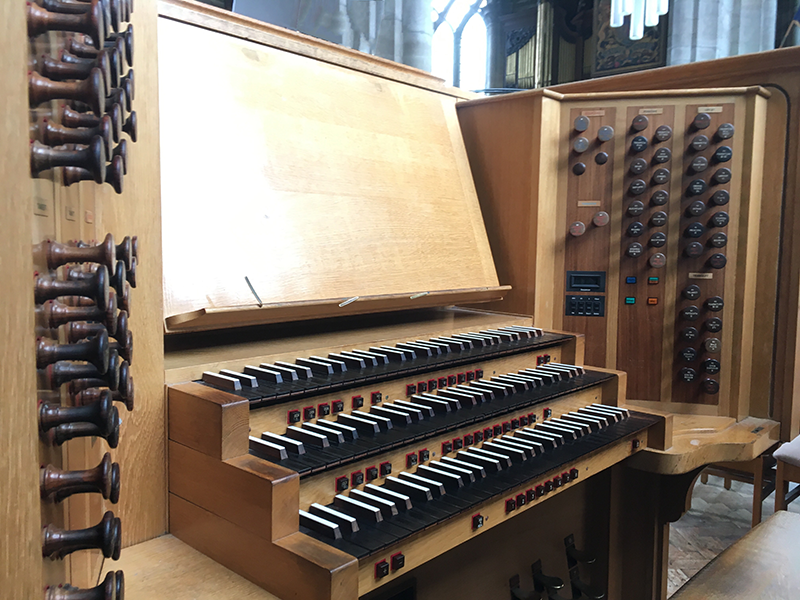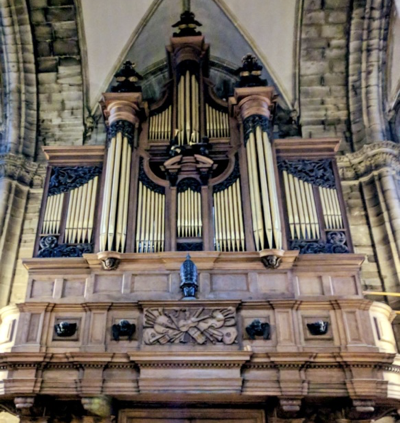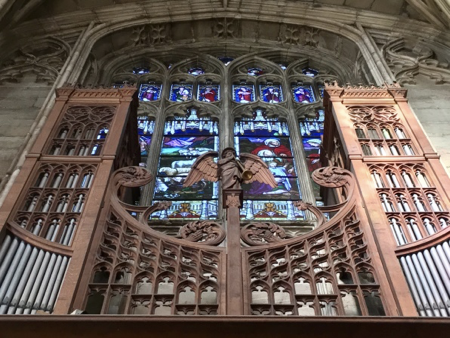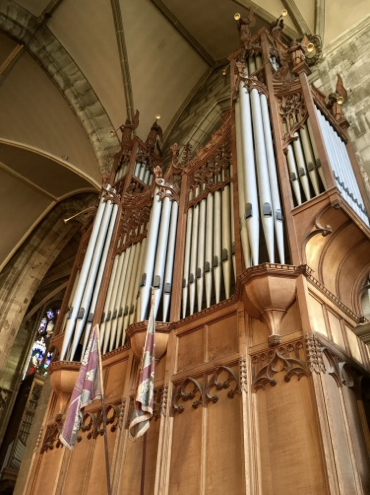The Organs of St Mary's Church

St Mary's Church has three organs; one located at the West End and another in the North Transept. The third instrument is a movable chamber organ. All three are regularly used for services and concerts. Since 1980 the West End Organ (newly built by Nicholson of Malvern) and remodeled Transept Organ are playable from the same console. The three-stop chamber organ was built in 1993 by Richard Moore of Leamington Spa.
An illustrated booklet is available from St Mary's Gift Shop: The Organs and Organists of the Collegiate Church of St Mary, Warwick by Charles Matthews and Alan Baker.
The History of the Organs



The earliest mention of any organ in the Collegiate Church of St Mary, Warwick, comes in medieval times when an instrument stood on a stone screen under the Choir arch. Little detail is known about this instrument, but what is certain is that it was destroyed in the fire of 1694, which also claimed the 14th-century Nave and Tower of the Church and destroyed much of Warwick’s town centre as well.
When the Church was rebuilt, a new organ was placed on a screen between the Nave and Chancel by Thomas Schwarbrick, a German organ builder who had settled in Warwick. This work was completed in 1717, and the organ remained in that position until 1795 when it was removed to the West gallery of the church where the case remains to this day, although slightly larger now than its original form. The craftsmanship of the case is particularly fine, the carving at its base being by Grinling Gibbons. Nothing remains of the old organ except the draw stops, which had been sawn off and were in a bucket, ready to be thrown away.
During the next hundred years, the instrument was modified and enlarged on a number of occasions, most notably by Bishop in 1834, Banfield in 1836 and 1842, and a rather more thorough restoration by Hill in 1865, when the West case was brought slightly further forward. By the end of the 19th century it was evident that drastic action had to be taken with the organ, and so in 1897 Robert Hope-Jones was invited to provide a new instrument. This was one of the first organs in the country to have electro-pneumatic action. It had a four-manual console, some thirty-six speaking stops, and was spread over the church in four separate cases: one in the Chancel (containing the Choir division), one each on the north-east and south-east transept walls (containing the Swell and Great divisions respectively), and the solo and larger parts of the pedal organ were in the old Schwarbrick West case. In order to accommodate and hide the huge 32-foot pipes, the case had to be moved back to its pre-1865 position, widened, and a central tower of pipes put in. This organ lasted for almost another hundred years, tonal adjustments and additions being made by Norman and Beard (1918), Compton (1928) and a more substantial rebuild in 1966 by the Northampton firm of Alfred E. Davies and Son Ltd.
The present specification was drawn up by the organist, Andrew Fletcher, in consultation with Roy Massey, and was built by the firm of Nicholson and Co. Ltd. of Worcester in 1980. The aim was to produce an instrument well able to serve all the needs for accompanying the fine Collegiate Church Choir and also to be a versatile recital instrument. The result is effectively two organs played from one console in the Nave. The two-manual transept organ, now contained entirely in the north-east case (although the empty chancel and southeast cases remain in the Church to this day) retains much of the old Hope-Jones pipework and is most English in character, whereas the West organ, in the enlarged Schwarbrick case, is a neo-classically-voiced three-manual organ, ideally suited to the demands of the European organ schools. Both organs can be played singly, or used together to great effect.
Further small tonal modifications and a modernisation of the console were completed in 1998.
The church also possesses a three-stop chamber organ, made in 1993 by Richard Moore of Leamington Spa. Situated in the Chancel, it is sometimes used to accompany mid-week choral services there, but can be moved to any location in the church and is often used in concerts or in services including music of the 18th century or earlier.